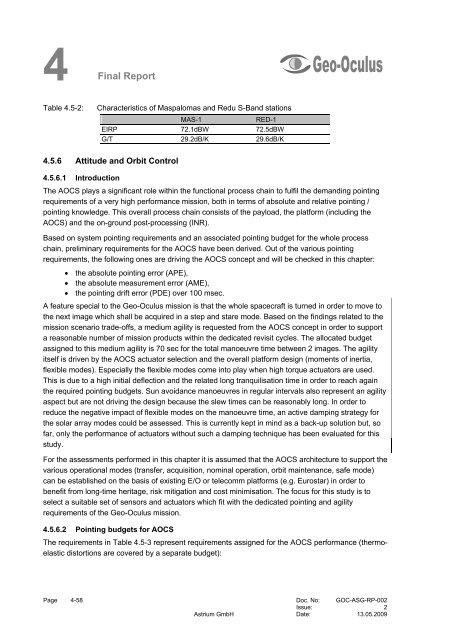4 Final Report - Emits - ESA
4 Final Report - Emits - ESA
4 Final Report - Emits - ESA
You also want an ePaper? Increase the reach of your titles
YUMPU automatically turns print PDFs into web optimized ePapers that Google loves.
4 <strong>Final</strong><br />
<strong>Report</strong><br />
Table 4.5-2: Characteristics of Maspalomas and Redu S-Band stations<br />
MAS-1 RED-1<br />
EIRP 72.1dBW 72.5dBW<br />
G/T 29.2dB/K 29.6dB/K<br />
4.5.6 Attitude and Orbit Control<br />
4.5.6.1 Introduction<br />
The AOCS plays a significant role within the functional process chain to fulfil the demanding pointing<br />
requirements of a very high performance mission, both in terms of absolute and relative pointing /<br />
pointing knowledge. This overall process chain consists of the payload, the platform (including the<br />
AOCS) and the on-ground post-processing (INR).<br />
Based on system pointing requirements and an associated pointing budget for the whole process<br />
chain, preliminary requirements for the AOCS have been derived. Out of the various pointing<br />
requirements, the following ones are driving the AOCS concept and will be checked in this chapter:<br />
• the absolute pointing error (APE),<br />
• the absolute measurement error (AME),<br />
• the pointing drift error (PDE) over 100 msec.<br />
A feature special to the Geo-Oculus mission is that the whole spacecraft is turned in order to move to<br />
the next image which shall be acquired in a step and stare mode. Based on the findings related to the<br />
mission scenario trade-offs, a medium agility is requested from the AOCS concept in order to support<br />
a reasonable number of mission products within the dedicated revisit cycles. The allocated budget<br />
assigned to this medium agility is 70 sec for the total manoeuvre time between 2 images. The agility<br />
itself is driven by the AOCS actuator selection and the overall platform design (moments of inertia,<br />
flexible modes). Especially the flexible modes come into play when high torque actuators are used.<br />
This is due to a high initial deflection and the related long tranquilisation time in order to reach again<br />
the required pointing budgets. Sun avoidance manoeuvres in regular intervals also represent an agility<br />
aspect but are not driving the design because the slew times can be reasonably long. In order to<br />
reduce the negative impact of flexible modes on the manoeuvre time, an active damping strategy for<br />
the solar array modes could be assessed. This is currently kept in mind as a back-up solution but, so<br />
far, only the performance of actuators without such a damping technique has been evaluated for this<br />
study.<br />
For the assessments performed in this chapter it is assumed that the AOCS architecture to support the<br />
various operational modes (transfer, acquisition, nominal operation, orbit maintenance, safe mode)<br />
can be established on the basis of existing E/O or telecomm platforms (e.g. Eurostar) in order to<br />
benefit from long-time heritage, risk mitigation and cost minimisation. The focus for this study is to<br />
select a suitable set of sensors and actuators which fit with the dedicated pointing and agility<br />
requirements of the Geo-Oculus mission.<br />
4.5.6.2 Pointing budgets for AOCS<br />
The requirements in Table 4.5-3 represent requirements assigned for the AOCS performance (thermoelastic<br />
distortions are covered by a separate budget):<br />
Page 4-58 Doc. No: GOC-ASG-RP-002<br />
Issue: 2<br />
Astrium GmbH Date: 13.05.2009

















